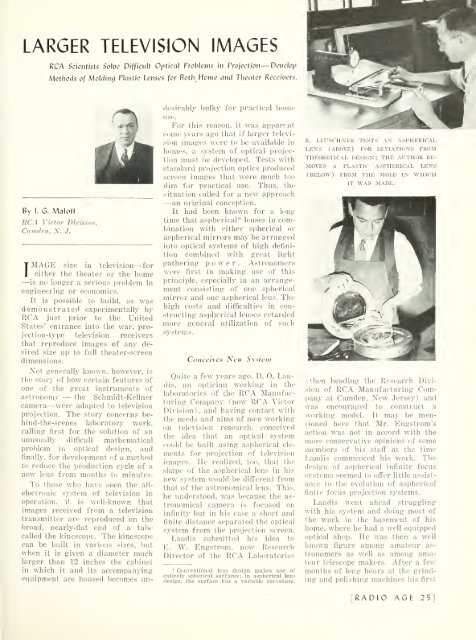Radio Age - 1944, January - 36 Pages, 3.3 MB ... - VacuumTubeEra
Radio Age - 1944, January - 36 Pages, 3.3 MB ... - VacuumTubeEra
Radio Age - 1944, January - 36 Pages, 3.3 MB ... - VacuumTubeEra
You also want an ePaper? Increase the reach of your titles
YUMPU automatically turns print PDFs into web optimized ePapers that Google loves.
LARGER TELEVISION<br />
IMAGES<br />
RCA Scientists Solve Difficult Optica/ Problems in Projection— Develop<br />
Methods of Moldinii Plastic Lenses for Both Home and Theater Keceiuers.<br />
By I.<br />
G. Maloff<br />
RCA Victor Division,<br />
Camden, N. J.<br />
IMAGE<br />
size in television—for<br />
either the theater or the home<br />
— is no longer a serious problem in<br />
engineering or economics.<br />
It is possible to build, as was<br />
demonstrated experimentally by<br />
RCA just prior to the United<br />
States' entrance into the war, projection-type<br />
television receivers<br />
that reproduce images of any desired<br />
size up to full theater-screen<br />
dimensions.<br />
Not generally known, however, is<br />
the story of how certain features of<br />
one of the great instruments of<br />
astronomy — the Schmidt-Kellner<br />
camera—were adapted to television<br />
projection. The story concerns behind-the-scenes<br />
laboratory work,<br />
calling first for the solution of an<br />
unusually difficult mathematical<br />
problem in optical design, and<br />
finally, for development of a method<br />
to reduce the production cycle of a<br />
new lens from months to minutes.<br />
To those who have seen the allelectronic<br />
system of television in<br />
operation, it is well-known that<br />
images received from a television<br />
transmitter are reproduced on the<br />
broad, nearly-flat end of a tube<br />
called the kinescope. The kinescope<br />
can be built in various sizes, but<br />
when it is given a diameter much<br />
larger than 12 inches the cabinet<br />
in which it and its accompanying<br />
equipment are housed becomes undesirably<br />
bulky for practical home<br />
use.<br />
For this reason, it was apparent<br />
some years ago that if larger television<br />
images were to be available in<br />
homes, a system of optical projection<br />
must be developed. Tests with<br />
standard projection optics produced<br />
screen images that were much too<br />
dim for practical use. Thus, the<br />
situation called for a new approach<br />
—an original conception.<br />
It had been known for a long<br />
time that aspherical* lenses in combination<br />
with either spherical or<br />
aspherical mirrors may be arranged<br />
into<br />
optical systems of high definition<br />
combined with great light<br />
gathering power. Astronomers<br />
were first in making use of this<br />
principle, especially in an arrangement<br />
consisting of one spherical<br />
mirror and one aspherical lens. The<br />
high costs and difficulties in constructing<br />
aspherical lenses retarded<br />
more general utilization of such<br />
svstcms.<br />
Conceives Nen' System<br />
Quite a few years ago. D. O. Landis,<br />
an optician working in the<br />
laboratories of the RCA Manufacturing<br />
Company (now RCA Victor<br />
Division), and having contact with<br />
the needs and aims of men working<br />
on television research, conceived<br />
the idea that an optical system<br />
could be built using aspherical elements<br />
for projection of television<br />
images. He realized, too, that the<br />
shape of the aspherical lens in his<br />
new system would be different from<br />
that of the astronomical lens. This,<br />
he understood, was because the astronomical<br />
camera is focused on<br />
infinity but in his case a short and<br />
finite distance separated the optical<br />
system from the projection screen.<br />
Landis submitted his idea to<br />
E. W. Engstrom, now Research<br />
Director of the RCA Laboratories<br />
* Conventional lens design makes use of<br />
entirely spherical surfaces; in aspherical lens<br />
design, the surface has a variable curvature.<br />
R. LEUSCHNER TESTS AN ASPHERICAL<br />
LENS (ABOVE) FOR DEVIATIONS FROM<br />
THEORETICAL DESIGN; THE AUTHOR RE-<br />
MOVES A PLASTIC ASPHERICAL LENS<br />
(BELOW) FROM THE MOLD IN WHICH<br />
IT WAS MADE.<br />
(then heading the Research Division<br />
of RCA Manufacturing Company<br />
at Camden, New Jersey) and<br />
was encouraged to construct a<br />
working model. It may be mentioned<br />
here that Mr. Engstrom's<br />
action was not in accord with the<br />
more conservative opinions of some<br />
members of his stafi" at the time<br />
Landis commenced his work. The<br />
design of aspherical infinite focus<br />
systems seemed to oflFer little assistance<br />
to the evolution of aspherical<br />
finite focus projection systems.<br />
Landis went ahead struggling<br />
with his system and doing most of<br />
the work in the basement of his<br />
home, where he had a well equipped<br />
optical shop. He was then a well<br />
known figure among amateur astronomers<br />
as well as among amateur<br />
telescope makers. After a few<br />
months of long hours at the grinding<br />
and polishing machines his first<br />
[RADIO AGE 25]
















